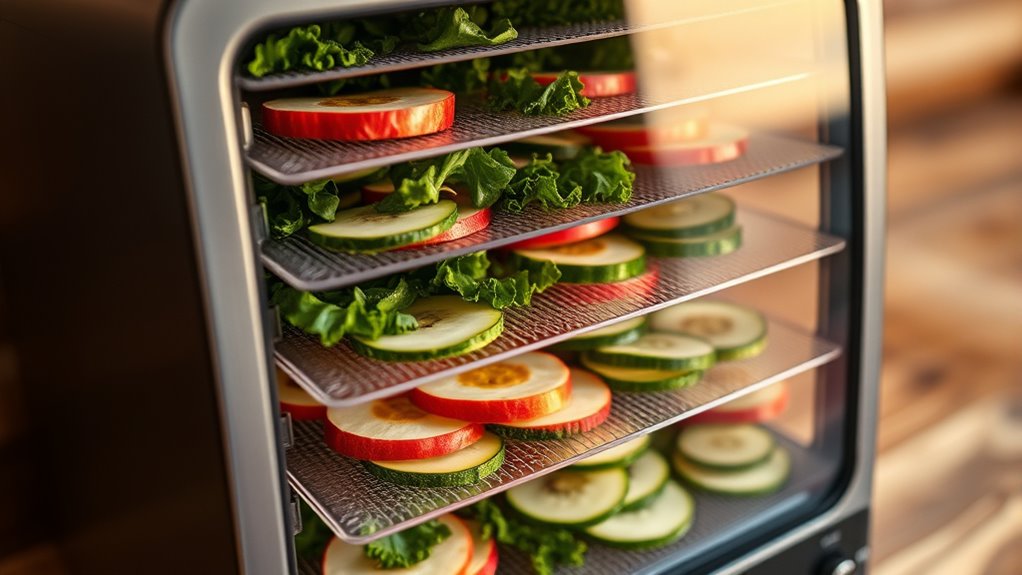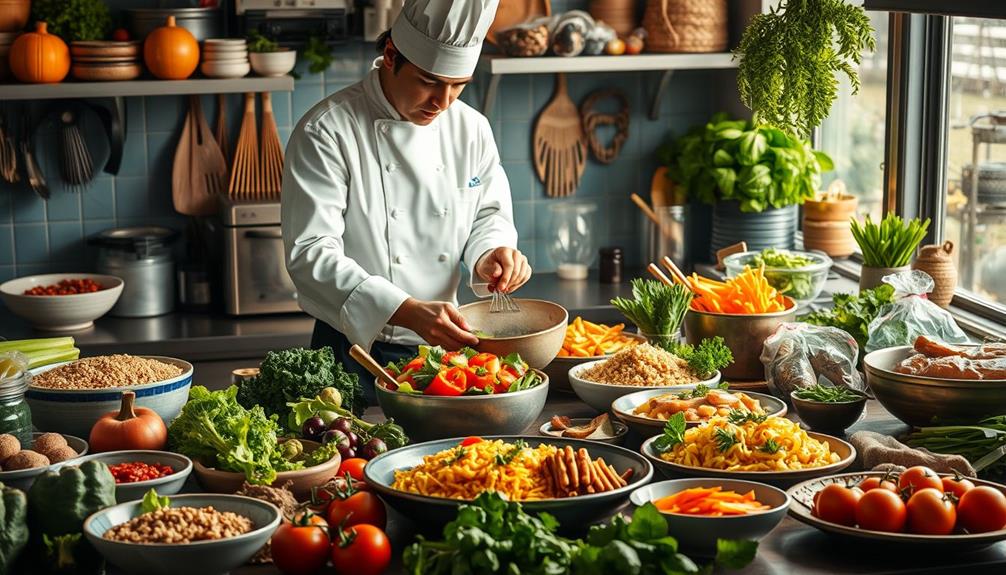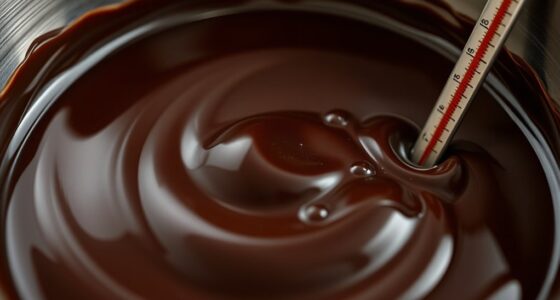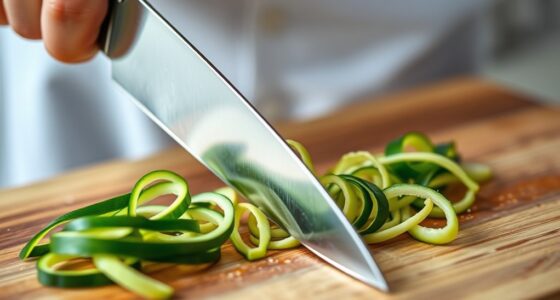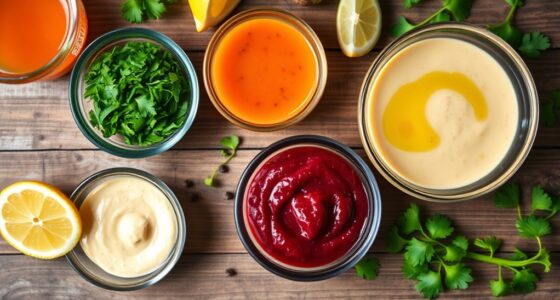To preserve nutrients and flavor, set your dehydrator to a low heat between 125°F and 135°F for raw foods like fruits. Slice items evenly and monitor the drying process, which usually takes 6 to 12 hours. Thinner slices dry faster, so check regularly to prevent over-drying. Proper control of temperature and timing ensures vibrant, nutrient-rich results. Keep things ideal, and you’ll uncover more tips for perfect dehydration as you continue.
Key Takeaways
- Maintain temperatures between 125°F and 135°F to preserve nutrients and prevent cooking during dehydration.
- Typical dehydration times range from 6 to 12 hours, depending on fruit thickness and moisture content.
- Slice fruits uniformly to ensure even drying and prevent over- or under-drying.
- Regularly check dried foods for pliability and avoid sticky or moist textures for optimal quality.
- Store dried fruits in airtight, cool, dark places to preserve flavor, nutrients, and extend shelf life.
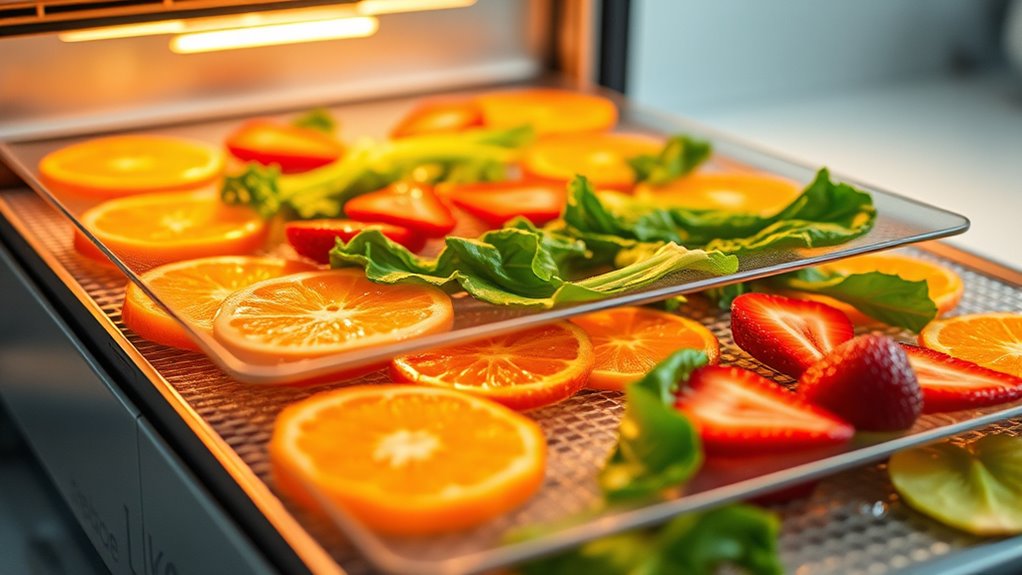
Dehydrating raw foods is an effective way to preserve their nutrients, extend shelf life, and create convenient snacks. When it comes to fruit preservation, using low heat ensures you retain the maximum nutrients, especially vitamins and enzymes that are sensitive to high temperatures. By carefully controlling your dehydration times and temperatures, you can produce perfectly dried fruits that not only taste great but also keep their nutritional value intact. This method is ideal if you’re aiming for nutrient retention, as it minimizes the loss of antioxidants and other beneficial compounds that degrade with heat.
For fruit preservation, maintaining a low temperature—typically around 125°F or 135°F—is essential. This range allows the fruit to dry thoroughly without cooking or losing flavor and nutrients. The drying time depends on the fruit’s moisture content and thickness, but generally, it takes anywhere from 6 to 12 hours. Thinner slices dry faster, so slice fruits uniformly to ensure even dehydration. Keep in mind that some fruits with high moisture content, like berries or peaches, may require longer drying times, while thinner apple slices dry more quickly. Regularly checking your dehydrator prevents over-drying or under-drying, which can impact texture and nutrient content.
Using a low-temperature setting preserves the fruit’s natural sugars and vibrant colors while preventing the destruction of heat-sensitive nutrients. For example, vitamin C, a key antioxidant, is particularly vulnerable to heat, so lower temperatures help retain its potency. Properly dried fruit should be pliable yet not sticky or moist, indicating that it’s been dehydrated at the right temperature and time. Additionally, choosing the appropriate dehydration time can help maintain the dog-friendly quality of the dried fruit if you are preparing treats for canine consumption. Once dried, store your fruits in airtight containers in a cool, dark place to prevent oxidation and moisture reabsorption, which can compromise both flavor and nutrients.
Frequently Asked Questions
Can I Dehydrate Cooked Foods Using This Method?
You can dehydrate cooked foods using this method, but keep in mind that it’s mainly designed for raw foods and low-heat techniques. Dehydrating cooked foods may affect flavor retention and texture, as the heat from cooking already alters these qualities. For best results, choose foods with minimal moisture and avoid overcooking, since it helps preserve flavor and keeps the dehydrated product tasty and enjoyable.
How Do I Prevent Raw Foods From Sticking During Dehydration?
Ever wonder how to keep your raw foods from sticking during dehydration? You can prevent this by using non-stick mats and ensuring proper spacing between items. Non-stick mats create a smooth surface that reduces sticking, while proper spacing allows air to circulate evenly, preventing clumping. Do you want your dehydrated foods to come out perfectly dry and intact? Just remember to use these simple tools and techniques for the best results.
Is It Safe to Dehydrate Produce With Pesticides?
It’s not entirely safe to dehydrate produce with pesticide residues, even if you wash it. Organic certification ensures that fruits and veggies are grown without harmful pesticides, reducing your exposure. To stay safe, choose organic produce whenever possible, wash everything thoroughly, and consider peeling or slicing thick-skinned fruits. Dehydrating won’t eliminate all pesticide residues, so prioritizing organic options helps protect your health during the dehydration process.
Can Dehydration Improve the Shelf Life of Raw Foods?
Dehydration definitely improves the shelf life of raw foods by removing moisture that bacteria and mold need to grow. It also helps preserve nutritional benefits and flavor, making snacks more flavorful and nutrient-dense over time. By carefully controlling times and temperatures, you can maintain the food’s quality while extending its usability, so you get maximum health benefits and flavor preservation in your dried goods.
How Do Storage Conditions Affect Raw Dehydrated Foods?
Think of your dehydrated foods as delicate seeds needing a cozy, stable environment to thrive. You must keep storage humidity low and guarantee temperature stability, or your preserved foods could turn to dust or mold. Fluctuating conditions invite spoilage, while consistent, cool storage preserves flavor and nutrients. By maintaining these conditions, you’re safeguarding your raw foods, allowing them to remain vibrant and fresh, like a garden in full bloom long after harvest.
Conclusion
Now that you know the ideal times and temperatures, dehydrating raw foods becomes simple and efficient. Did you know that properly dehydrated foods can last up to a year without refrigeration? That’s almost as long as some vacations! By following these low-heat guidelines, you’ll preserve nutrients and flavor while extending shelf life. So, get your dehydrator ready—your healthy snacks and meals are just a few hours away!

